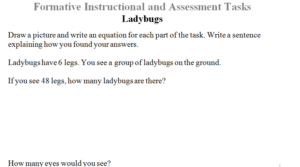Use multiplication and division within 100 to solve word problems in situations involving equal groups, arrays, and measurement quantities, e.g., by using drawings and equations with a symbol for the unknown number to represent the problem.
[divider] [/divider] Students are able to…
- Identify the information given in the problem and explain their thinking using multiplication and division vocabulary (groups, factor, total and product).
- Represent multiplication and division problems visually.
- Use mathematical symbols to represent the problem situation.
[divider] [/divider] Students are able to…because teachers:
- Provide students with a variety of equal group multiplication situations and have them model each situation to solve the problem.
- Provide students with related partitive (fair share) division situations in which they identify the given information (total number of items, number of groups) and find the total number of items in each group.
- Provide students with related measurement division situations in which they identify the given information (total number of items and number of items in each group) and find the number of groups.
[divider] [/divider] Questions to ask students:
- What does each value in the problem represent?
- Sample answer that indicates understanding given a sample problem such as, “I have 15 oranges and I want to put 3 oranges in each bag. How many bags will I need?”: The 15 is the total amount of oranges and the 3 is the number of items in each group.
- What are you trying to find?
- Sample answer that indicates understanding given the same sample problem used above: I have to find the number of bags, or equal groups.
- What operation will you use to solve that problem? Why?
- Sample answer that indicates understanding given the same sample problem used above: I will use division, because I know my total amount and I am separating it into equal groups.
[divider] [/divider] FSA Notes :
Cognitive Complexity Level: 2 – Basic Application of Skills and Concepts
Achievement Level Descriptors:
2- multiplies and divides with factors and divisors of 1, 2, or 5 to solve word problems involving equal groups and arrays
3- multiplies and divides with factors and divisors that are less than or equal to 10 to solve word problems involving equal groups, arrays, and measurement quantities; writes an equation with a symbol to represent the unknown
4- multiplies and divides within 100 using a variety of strategies to solve two-step word problems
5- [intentionally left blank]
Assessment Limits:
All values in items may not exceed whole number multiplication facts of 10 x 10 or the related division facts.
Items may not contain more than one unknown per equation.
Items may not contain the words “times as much/many.”
[divider] [/divider] Additional Resources:
Additional in depth content knowledge
Blog Post: Five things to know about using array models to connect multiplication and division
Learn Zillion Videos:
Solve Word Problems using the Idea of Equal Groups
Visualizing a Division Word Problem
Solve Division Problems Using Arrays
Solve Multiplication Problems By Drawing an Array
[divider] [/divider] Sample Formative Assessment Tasks:
[divider] [/divider] Resources/Tasks to Help your Child at Home:
Look for real-world examples of situations with equal groups. For example: packs of candy, cartons of eggs, six-pack of soda, tires on vehicles, etc. (If we bought 3 six-packs of Pepsi, how many Pepsi cans did we buy?)
As your child is making sense of multiplication and division story problems, ask them questions such as:
- What is the total amount?
- How many groups are there?
- How many are there in each group?
- How do you know it is a multiplication/division story problem?
Key Words aren’t the Key to Understanding Math
Math Playground Thinking Blocks: Multiplication and Division


